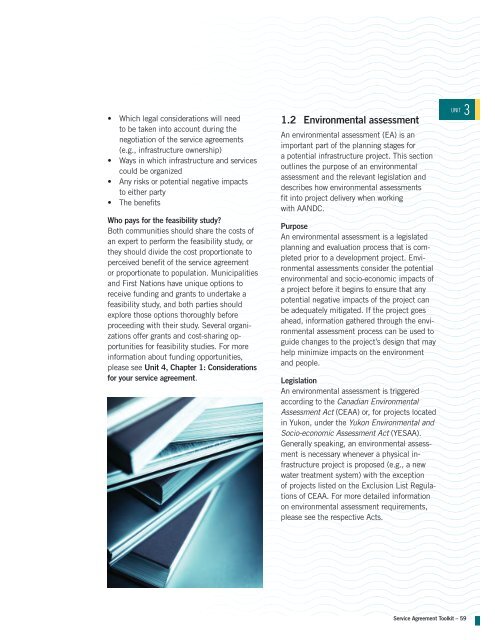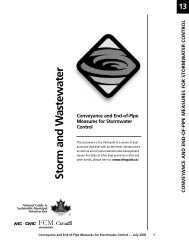Guide to Service Agreements - FCM
Guide to Service Agreements - FCM
Guide to Service Agreements - FCM
Create successful ePaper yourself
Turn your PDF publications into a flip-book with our unique Google optimized e-Paper software.
• Which legal considerations will need<br />
<strong>to</strong> be taken in<strong>to</strong> account during the<br />
negotiation of the service agreements<br />
(e.g., infrastructure ownership)<br />
• Ways in which infrastructure and services<br />
could be organized<br />
• Any risks or potential negative impacts<br />
<strong>to</strong> either party<br />
• The benefits<br />
Who pays for the feasibility study?<br />
Both communities should share the costs of<br />
an expert <strong>to</strong> perform the feasibility study, or<br />
they should divide the cost proportionate <strong>to</strong><br />
perceived benefit of the service agreement<br />
or proportionate <strong>to</strong> population. Municipalities<br />
and First Nations have unique options <strong>to</strong><br />
receive funding and grants <strong>to</strong> undertake a<br />
feasibility study, and both parties should<br />
explore those options thoroughly before<br />
proceeding with their study. Several organizations<br />
offer grants and cost-sharing opportunities<br />
for feasibility studies. For more<br />
information about funding opportunities,<br />
please see Unit 4, Chapter 1: Considerations<br />
for your service agreement.<br />
1.2 Environmental assessment<br />
An environmental assessment (EA) is an<br />
important part of the planning stages for<br />
a potential infrastructure project. This section<br />
outlines the purpose of an environmental<br />
assessment and the relevant legislation and<br />
describes how environmental assessments<br />
fit in<strong>to</strong> project delivery when working<br />
with AANDC.<br />
Purpose<br />
An environmental assessment is a legislated<br />
planning and evaluation process that is completed<br />
prior <strong>to</strong> a development project. Environmental<br />
assessments consider the potential<br />
environmental and socio-economic impacts of<br />
a project before it begins <strong>to</strong> ensure that any<br />
potential negative impacts of the project can<br />
be adequately mitigated. If the project goes<br />
ahead, information gathered through the environmental<br />
assessment process can be used <strong>to</strong><br />
guide changes <strong>to</strong> the project’s design that may<br />
help minimize impacts on the environment<br />
and people.<br />
Legislation<br />
An environmental assessment is triggered<br />
according <strong>to</strong> the Canadian Environmental<br />
Assessment Act (CEAA) or, for projects located<br />
in Yukon, under the Yukon Environmental and<br />
Socio-economic Assessment Act (YESAA).<br />
Generally speaking, an environmental assessment<br />
is necessary whenever a physical infrastructure<br />
project is proposed (e.g., a new<br />
water treatment system) with the exception<br />
of projects listed on the Exclusion List Regulations<br />
of CEAA. For more detailed information<br />
on environmental assessment requirements,<br />
please see the respective Acts.<br />
UNIT 3<br />
<strong>Service</strong> Agreement Toolkit – 59
















